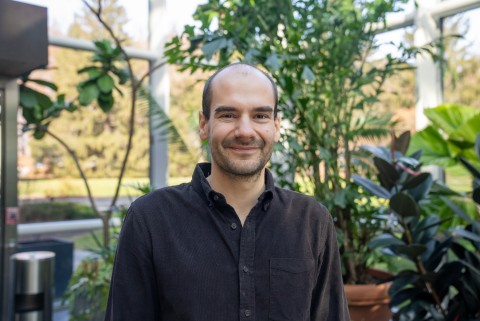Imagine peering into our prebiotic environment, a chaotic time when simple molecules danced and eventually coalesced into novel forms of life. In this ancient world, a discovery by Jack Szostak's lab has shined a light on how life might have found a way to establish itself and become self-sustaining.
Building on previous research into the Origins of Life, a new study published in Science Advances by the group describes a self-sustaining chimeric ribozyme composed of long RNA pieces bridged by intervening amino acids. This remarkable molecule can both make more of itself from smaller fragments and build other chimeric amino acid-bridged RNA molecules. This dual ability suggests that such a ribozyme could have been part of a key mechanism in early molecular evolution, where a single molecule could reproduce itself and also create other functional molecules, helping more complex systems arise at the beginning of life.

Self-replication is considered a fundamental step for any system to be classified as 'alive.' Aleksandar Radakovic, a postdoc at the University of Chicago and the lead author of the study, underscored this point by highlighting the central role of autocatalysis in their findings. Autocatalysis, in essence, means a reaction speeds up as it progresses because the molecules it produces help create more of themselves.
Initially, the researchers questioned whether their observations of a self-sustaining chimeric ribozyme were the result of chemical processes that by chance merely resembled self-replicating kinetics. To ensure their observations were correct, they carefully measured each reaction within the complex reaction system and constructed a detailed computational kinetic model. This model confirmed that the observed behavior could only be explained by self-replicating, or autocatalytic, kinetics.
Furthermore, Radakovic's team discovered that this autocatalytic process is reasonably robust. It functions across a wide range of temperatures - from just above freezing to room temperature - and within varying acidity levels. This resilience suggests to the researchers that the process could have occurred in the diverse environments present during early Earth's formation.
Radakovic stresses the importance of these self-accelerating reactions in understanding the origins of life, explaining that they can efficiently transform simple chemicals into complex biological components like genomes and enzymes. To illustrate this, he draws a parallel between the chimeric ribozyme and the modern ribosome: the ribosome participates in making all the components that sustain new ribosome production, including the RNA polymerase that makes the ribosomal RNA, but importantly it also makes all the proteins in the cell that go on to perform functions essential for cell survival.
“Similarly, our ribozyme synthesizes not only itself but also other, functionally unrelated chimeric ribozymes,” says Radakovic. “In essence, this ribozyme is a general ‘assembler’, which makes it a small but very useful cog in the machinery of primordial life.”
While the demonstration of self-replication and general chimeric ribozyme assembly is an important discovery on its own, the added bonus of this work is that it also implicates amino acids as key components in this assembly scheme. Radakovic notes that until recently, the part amino acids played in the early 'RNA World' remained ambiguous. Now, Radakovic and the Szostak lab can confirm these molecules weren't just bystanders; they served as a vital 'molecular glue,' thereby helping RNA pieces to assemble into more complex molecular architectures.
This result holds substantial importance, as it points to a potential evolutionary pathway toward the evolution of protein synthesis: if amino acid side chains begin participating in the catalytic mechanism of a chimeric ribozyme, this could drive selection for specific incorporation of amino acids into defined RNA sequences. Such sequence specific incorporation of amino acids is the fundamental basis of how our cells build proteins using ribosomes. By addressing a long-standing gap in our understanding, this work represents a step towards a more complete picture of early life's evolution.
"Studying RNA and amino acids on their own has yielded important insights into the origin of life but it has also failed to explain important phenomena, such as how modern life came to crucially depend on both RNA and amino acids,” Radakovic states.
“By chemically linking RNA and amino acids to create a chimeric ribozyme that sustains itself and spawns unrelated chimeric ribozymes, our work takes a tiny step in the direction of explaining this mystery."
Citation - Aleksandar Radakovic et al., Autocatalytic assembly of a chimeric aminoacyl-RNA synthetase ribozyme. Sci. Adv.11,eadu3693(2025).DOI:10.1126/sciadv.adu3693